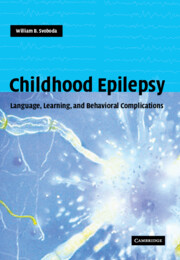Book contents
- Frontmatter
- Contents
- Preface
- Glossary
- 1 Looking ahead
- Part I Speech and language problems
- Part II Learning problems
- 12 Learning challenges
- 13 The development of learning
- 14 Learning difficulties
- 15 Learning problems with seizure types
- 16 Modifying factors
- 17 Transient cognitive impairments of epilepsy
- 18 Attention and alertness
- 19 Memory
- 20 Executive functioning
- 21 Academics
- 22 Antiepileptic medication effects
- 23 Effects of other therapies
- 24 Diagnosis
- 25 Gaining help
- 26 Frustrations of learning problems
- Part III Behavior problems
- Index
- References
26 - Frustrations of learning problems
from Part II - Learning problems
Published online by Cambridge University Press: 26 October 2009
- Frontmatter
- Contents
- Preface
- Glossary
- 1 Looking ahead
- Part I Speech and language problems
- Part II Learning problems
- 12 Learning challenges
- 13 The development of learning
- 14 Learning difficulties
- 15 Learning problems with seizure types
- 16 Modifying factors
- 17 Transient cognitive impairments of epilepsy
- 18 Attention and alertness
- 19 Memory
- 20 Executive functioning
- 21 Academics
- 22 Antiepileptic medication effects
- 23 Effects of other therapies
- 24 Diagnosis
- 25 Gaining help
- 26 Frustrations of learning problems
- Part III Behavior problems
- Index
- References
Summary
Psychosocial problems are common in children with epilepsy. These problems may lead to an increase in the seizure frequency as well as contributing to school problems. Many children with uncontrolled epilepsy have to cope not only with the seizures and subclinical discharges but also with underlying brain damage, drug effects, and the psychosocial problems, which in combination tend to cause or heighten learning difficulties (Henricksen, 1990). The child is increasingly frustrated and impeded in the development of age-appropriate adaptive behaviors.
Behavior affects learning
Learning disorders may be associated with behavior disorders such as conduct disorders, major depressive disorders, dysthymic disorders, and oppositional defiant disorders in 10–15% of cases in the non-epileptic population (Cornaggia & Gobbi, 2001). These same disorders are seen with increased frequency in children with epilepsy.
Emotional and behavior disorders may be a symptomatic expression of cognitive impairment in individuals with epilepsy. Behavior and mood disorders may cause reduced learning processing. There is a correlation between temporal lobe epilepsy and interictal affective and personality disturbances (Perini et al., 1996). Directed violence and self-destructive behavior have been described (Kanemoto et al., 1999) in postictal psychoses (Cornaggia & Gobbi, 2001).
Epileptic child underachievers tend to be depressed (Bagley, 1970; Rutter et al., 1970; Palkes et al., 1982). Depression may impede mental processing, resulting in a more globally impaired cognitive profile, thereby obscuring the localizing value of IQ testing results. Patients with more diffuse impairments may be at a greater risk for depression.
- Type
- Chapter
- Information
- Childhood EpilepsyLanguage, Learning and Behavioural Complications, pp. 396 - 404Publisher: Cambridge University PressPrint publication year: 2004



